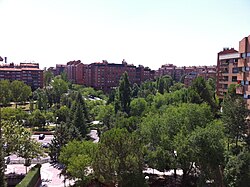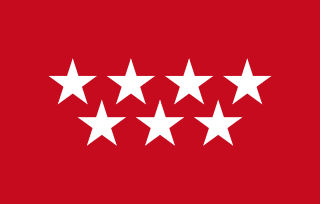
The Community of Madrid is one of the seventeen autonomous communities of Spain. It is located in the centre of the Iberian Peninsula, and of the Central Plateau. Its capital and largest municipality is the City of Madrid, which is also the capital of the country. The Community of Madrid is bounded to the south and east by Castilla–La Mancha and to the north and west by Castile and León. It was formally created in 1983, based on the limits of the province of Madrid, which was until then conventionally included in the historical region of New Castile.

Balmaseda is a town and municipality located in the province of Biscay, in the Basque Country. Balmaseda is the capital city of the comarca of Enkarterri, in western Biscay and serves an important role in the province thanks to its proximity to the capital city of Bilbao and the regions of Cantabria and Castile and León.

Getafe is a municipality and a city in Spain belonging to the Community of Madrid. As of 2018, it has a population of 180,747, the region's sixth most populated municipality.

Lope de Vega, officially the Municipality of Lope de Vega, is a 4th class municipality in the province of Northern Samar, Philippines. According to the 2020 census, it has a population of 14,690 people.
Soto del Real, whose former name was Chozas de la Sierra, is a town and municipality in the northern area of the autonomous Community of Madrid which had 9,188 inhabitants in 2022.

San Sebastián de los Reyes is a municipality in the Community of Madrid, Spain. Founded in 1492, it is located 20 kilometres (12 mi) north of Madrid.

Colmenar Viejo is a town and municipality of about 48,614 inhabitants, located in the Community of Madrid, Spain, 30 kilometers north of Madrid on the M-607 motorway. It belongs to the comarca of Cuenca Alta del Manzanares.

Cercanías Madrid is the commuter rail service that serves Madrid, the capital of Spain, and its metropolitan area. It is operated by Cercanías Renfe, the commuter rail division of Renfe, the former monopoly of rail services in Spain. Its total length is 370 km.
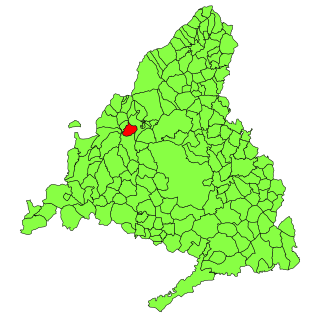
Collado Villalba is a municipality of the Community of Madrid, in central Spain. It is located 40.3 kilometres north-west of the city of Madrid, at an altitude of 917 meters above sea level. It has a population of 63,679 (2019), with a population density of about 2,400 per km². Collado Villalba has a hot summer Mediterranean climate.

San Agustín del Guadalix is a Spanish town located north of the Comunidad de Madrid, near to Sierra de Guadarrama.

Manzanares el Real is a 8,936 inhabitant town in the northern area of the autonomous Community of Madrid. It is located at the foot of The Pedriza, a part of the Sierra de Guadarrama, and next to the embalse de Santillana.

The BESCAM, an acronym for Brigadas Especiales de Seguridad de la Comunidad Autónoma de Madrid, is a police body created by the government of the Community of Madrid in Spain. It is not a specific police organization but rather a project of the regional government of the Autonomous Community of Madrid 2500 which aims to fund local police distributed among the different municipalities of the Community in response to strict technical criteria, with particular emphasis on the population, geographic location or, in the case of those with fewer than 25,000 inhabitants, taking into account the seasonal population increase, or other factors such as low levels of police staffing, industrial development and urban growth. In early 2008, 2,500 agents, distributed in 102 locations in the Greater Madrid area that have a local police force, were members of these units.

Agrupación Deportiva Colmenar Viejo is a club of football of Colmenar Viejo in the Community of Madrid, in Spain. Founded as a non-professional club in 1967, it has been playing in the regional Preferente, at the fifth level of the Spanish football league system, since the 2018–19 season. The club plays its home matches at Campo Municipal de Deportes Alberto Ruiz, which has seating for 1,200 spectators.
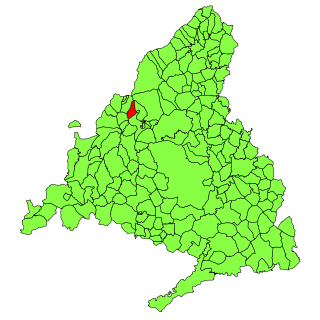
Moralzarzal is a town in Spain. It is located in the Sierra de Guadarrama, in the Community of Madrid. It had a population of 11,318 in 2008.
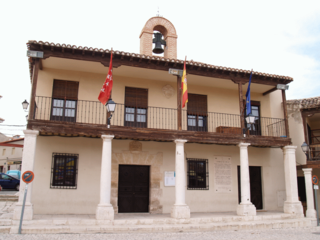
Colmenar de Oreja is a town and municipality of the Las Vegas comarca, in the Community of Madrid, Spain. It was subject to a seven-month siege in 1139.

Soto de Viñuelas is a meadow-oak forest north of the city of Madrid, south of Tres Cantos and San Agustín del Guadalix, east of the Monte de El Pardo and west of San Sebastián de los Reyes, all municipalities are parts of the Community of Madrid, Spain. Much of it is a fenced property of 3,000 hectares, which includes important ecological values, landscape and art. It belongs to the municipality of Madrid, although it contains small areas to the north, corresponding to Tres Cantos, including a development of the same name. Other developments nearby are Ciudalcampo and Fuente del Fresno, situated on its western boundary. King's College, the British School of Madrid, is also located in the development of Soto de Viñuelas, abutting the Regional Park. In 1985 Soto de Viñuelas was turned into the Regional Park of the Cuenca Alta del Manzanares, the largest protected natural area in the region. It has been classified as Area B, a legal instrument that allows agricultural land use. Soto de Viñuelas also received the status of Special Protection Area for Birds. It is accessed from the M-607 Freeway, exit 20. Soto de Viñuelas and Tres Cantos are both listed on the exit sign.
Valdelaguna is a Spanish town in the province of Madrid. It is located southeast of the district, in Las Vegas region, 49 km from Madrid city. It is bordered by the towns of Chinchón, Belmonte de Tajo, Villarejo de Salvanés, Perales de Tajuña, Morata de Tajuña and Colmenar de Oreja. It covers an area of 41.89 km ², has an average altitude of 702 m and the adjective of its inhabitants is Abubillo / a. (Valdelaguneros).

The Cuenca Alta del Manzanares Regional Park, created in 1985, is the natural space protected area with the largest extension in the Community of Madrid (Spain) and one of the most ecologically and scenically valuable. It is located in the northwest of the region and extends around the upper course of the Manzanares River, along 42 583 ha. Its main municipalities of reference are Manzanares el Real and Hoyo de Manzanares. Unesco declared it a Biosphere Reserve in 1992.
